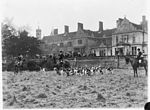Hawstead

Hawstead is a small village and civil parish in the West Suffolk district of Suffolk in eastern England. It is located 5 kilometres (3 mi) south of Bury St. Edmunds between the B1066 and A134 roads, in a fork formed by the River Lark and a small tributary. The place-name 'Hawstead' is first attested in the Domesday Book of 1086, where it appears as Haldsteada. The name is thought to mean 'a place of shelter for cattle'.Hawstead Place, previously the seat of the Drury family, is now a farmhouse. Sir William Drury was sheriff and knight of the shire for Suffolk. Lady Drury's Closet (also known as the Hawstead Panels), now in Christchurch Mansion in Ipswich, is a series of painted wooden panels of early 17th-century date. They originally decorated a painted closet adjacent to a bedroom in Hawstead Place. It is believed they were made for Anne Drury, Lady Drury, wife of Sir Robert Drury, who died in 1624. Lt Col Edward Robert Drury, son of Rev Sir William Drury, was the first General Manager and President of the Queensland Bank of Australia now the National Australia Bank; he named his Queensland home 'Hawstead' in 1875.
Excerpt from the Wikipedia article Hawstead (License: CC BY-SA 3.0, Authors, Images).Hawstead
Church Road, West Suffolk
Geographical coordinates (GPS) Address Nearby Places Show on map
Geographical coordinates (GPS)
| Latitude | Longitude |
|---|---|
| N 52.198 ° | E 0.719 ° |
Address
Park House
Church Road
IP29 5BF West Suffolk
England, United Kingdom
Open on Google Maps








